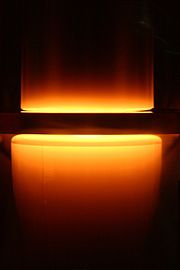Zone melting process

The zone melting process (also: " zone pulling") is a process for the production of high-purity single - crystal materials . Other names for zone melting are float zone processes , flow zone processes , zone cleaning, zone edge melting processes or zone floating.
It was developed in 1950/51 by William Gardner Pfann at Bell Laboratories .
Working principle
The zone melting process is based on the fact that impurities in the melt have a more energetically favorable chemical environment (lower chemical potential ) than in the solid and therefore migrate from the solid into the melt. The amount that is built into the crystal depends, among other things, on the type of contamination and the rate of solidification. In silicon, for example, the distribution coefficient of boron is 0.8 and that of iron 0.000007. Boron can hardly be removed from silicon with this method, but iron can be removed very well. A distinction is made between horizontal zone melting in an elongated boat and vertical crucible-free zone melting, which is particularly important in the production of high-purity silicon monocrystals.
Compare also the pedestal procedure and the Czochralski procedure .
Technique of Si zone melting
An already prepared, cleaned rod (or column) with a still polycrystalline crystal structure is in a protective atmosphere. By induction heating , a relatively narrow zone material is melted at one end. The rod rotates slowly so that the zone melts evenly. The melted zone is brought into contact with a seed crystal and grows onto it, assuming its crystal structure. This melting zone is now slowly moved through the rod. The melt, which cools down again, solidifies over the entire width of the material with a uniform crystal structure, so the desired single crystal is formed behind the melting zone. Foreign atoms largely remain in the melting zone and are finally deposited at the end of the column, which is removed after cooling. Repeated zone melting can further increase the purity. A doping can by adding gaseous achieved substances then penetrate into the melt. For special applications, the supply rod can be prepared with a small amount of metal, which is built into the crystal in a relatively constant concentration due to the mostly very small distribution coefficient (mostly> 99.9% remain in the melt). In contrast to crucible pulling, where column diameters of up to 12 inches (approx. 30 cm) are common, the zone melting process can only be used to produce column diameters of up to 20 cm. Larger diameters after this process are not to be expected in the foreseeable future.
application
This process enables the production of high purity silicon and other materials, but it is very costly.
The silicon is used, for example, in components of high energy technology , in microsystem technology , in the computer industry for integrated circuits (see also wafers ) or in photovoltaics for the production of solar cells . This silicon purity was not necessary in the past for solar cells in particular, so that more cost-effective processes have become established here (see solar cell, Czochralski process ). In spite of everything, the silicon for solar cell production is becoming increasingly pure in order to improve the efficiency of energy generation.

